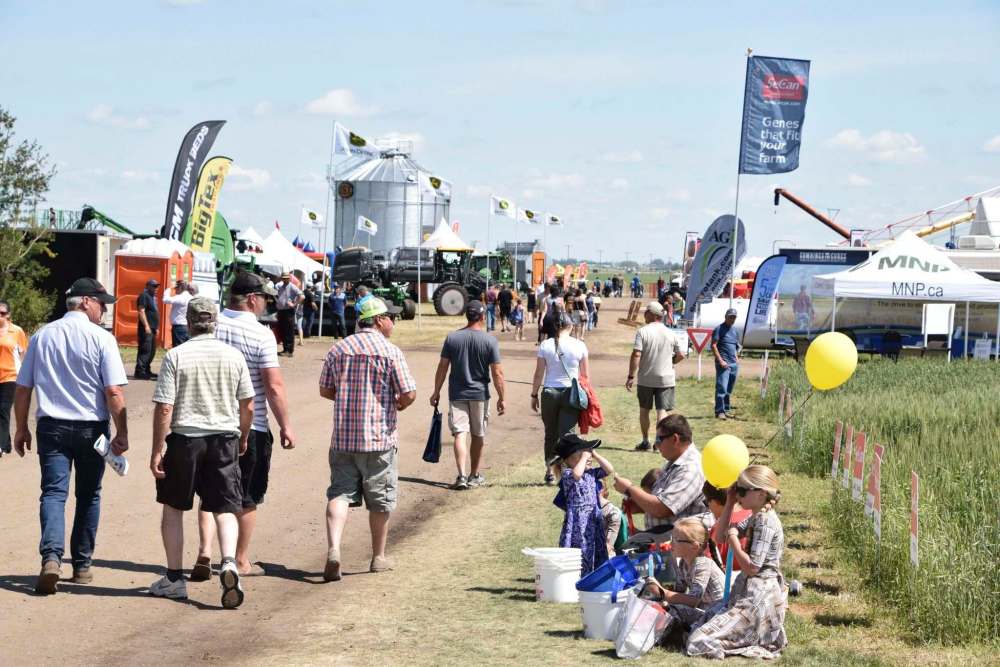Annual event showcases future of farming
Advertisement
Read this article for free:
or
Already have an account? Log in here »
To continue reading, please subscribe:
Monthly Digital Subscription
$0 for the first 4 weeks*
- Enjoy unlimited reading on winnipegfreepress.com
- Read the E-Edition, our digital replica newspaper
- Access News Break, our award-winning app
- Play interactive puzzles
*No charge for 4 weeks then price increases to the regular rate of $19.00 plus GST every four weeks. Offer available to new and qualified returning subscribers only. Cancel any time.
Monthly Digital Subscription
$4.75/week*
- Enjoy unlimited reading on winnipegfreepress.com
- Read the E-Edition, our digital replica newspaper
- Access News Break, our award-winning app
- Play interactive puzzles
*Billed as $19 plus GST every four weeks. Cancel any time.
To continue reading, please subscribe:
Add Free Press access to your Brandon Sun subscription for only an additional
$1 for the first 4 weeks*
*Your next subscription payment will increase by $1.00 and you will be charged $16.99 plus GST for four weeks. After four weeks, your payment will increase to $23.99 plus GST every four weeks.
Read unlimited articles for free today:
or
Already have an account? Log in here »
Hey there, time traveller!
This article was published 21/07/2018 (2676 days ago), so information in it may no longer be current.
Anyone driving west of Saskatoon during the third week of July gets a surprise just as they pass the small town of Langham.
Rising up from the prairie horizon is another city of sorts, one filled with grain bins, long lines of farm equipment and rows of tents housing more than 450 exhibitors.
The balloons and drones hovering over the site give it a festive feel but the farmers, often with young children trying to match them stride for stride as they make the rounds, are there on a mission.

Now in its fourth year, the annual Ag in Motion outdoor farm show hosted by Glacier FarmMedia has evolved into a show that attracts more than 30,000 farmers from all over the world. It’s turned into a new way to do its job for a company traditionally rooted in connecting farmers with industry innovations through publications.
The appeal for farmers is the fact that it’s held outdoors on a site big enough that they can actually see new technology in action. The daily demonstrations of new equipment on field-scale plots attract thousands of farmers who flock like seagulls to the test sites at the appointed times.
There is also room for seed developers to plant plots to show off the latest in new crops, new varieties, and to demonstrate new developments in crop protection or fertilizer management.
But innovations on display dive much deeper into some of the complex issues farmers face. A University of Saskatchewan researcher was recognized for her research that found grain damaged by the common crop disease fusarium head blight can be fed to mealworms, which then become protein that is usable for poultry feed. Normally, high infestations of fusarium make grain unfit for human or animal consumption.
Xarvio, a division of Bayer Crop Science, launched a free crop-scouting app that combines artificial intelligence (AI) with crowdsourcing of photos of commonly found weeds. When farmers photograph a plant with a mobile phone, it feeds into the identification algorithm, essentially making the app more robust the more it gets used. Spokesman Warren Bills said the app would eventually be able to reliably identify up to 50 of the most common weeds farmers face.
Less visible is the surge in sensor technology that has created a collision between Big Iron and Big Data unlike anything that’s ever been experienced in agriculture, says David Yee, vice-president of operations for the Prairie Agricultural Machinery Institute (PAMI), an independent research agency funded by the Manitoba and Saskatchewan governments.
“The latest John Deere tractor has anywhere from 110 to 300 sensors on it depending on the features you put on,” Yee told audiences in his daily presentations in one of the speakers’ tents.
The ability to monitor, measure and analyze — combined with blockchain distribution systems — is making it possible to deliver traceability to end users, which fosters trust in the system, he noted. In some cases, cost is an issue, but more often than not, the biggest factor delaying adoption of new ideas is user friendliness.
And with all the focus on the new stuff increasing productivity, sometimes the simple basics — such as harvest loss — get lost in the shuffle.
When it comes to food waste, consumers are by far the worst offenders in the food chain. But reducing the amount of grain that is lost or damaged during harvest affects how much farmers get paid.
That prompted PAMI and the Canola Council of Canada to develop a mobile-friendly interactive “combine optimization tool” (not an app) that helps farmers find the causes of grain losses, quality damage or efficiency during harvest.
When engineers delved into the issue, they found more than 50 ways a farmer can lose money during harvest, many of them related to calibration and speed.
It’s not shiny. It is information a farmer can find elsewhere, but it’s more accessible and using it pays off. Saved money is worth twice as much as dollars earned.
There is no shortage of ideas for making farming better. The trick for farmers is deciding which ones work best for their operations.
Laura Rance is editorial director at Glacier FarmMedia. She can be reached at 204-792-4382 or lrance@farmmedia.com

Laura Rance is editorial director at Farm Business Communications.
Our newsroom depends on a growing audience of readers to power our journalism. If you are not a paid reader, please consider becoming a subscriber.
Our newsroom depends on its audience of readers to power our journalism. Thank you for your support.
History
Updated on Saturday, July 21, 2018 7:30 AM CDT: Photo added

